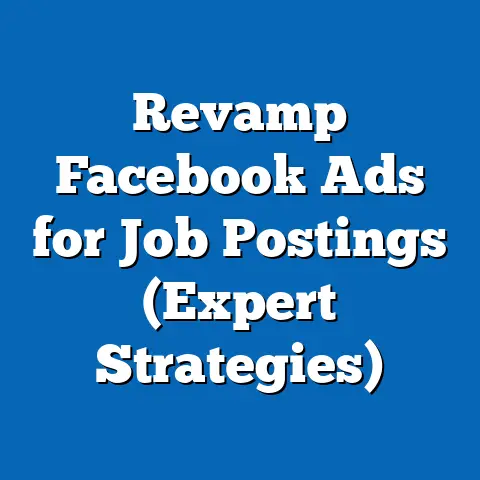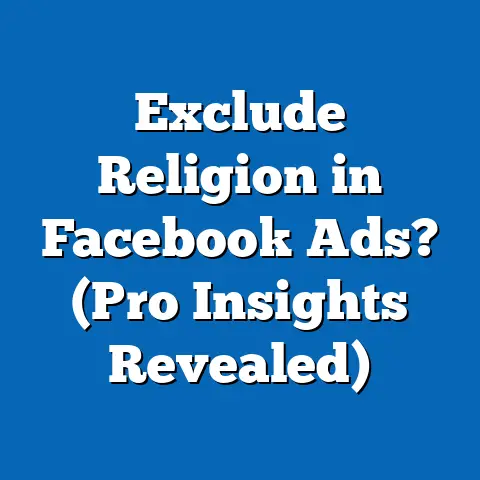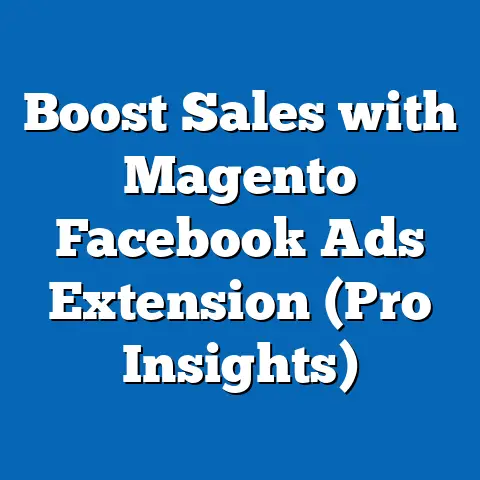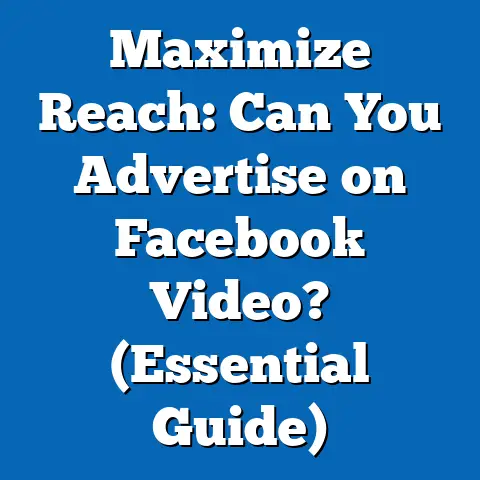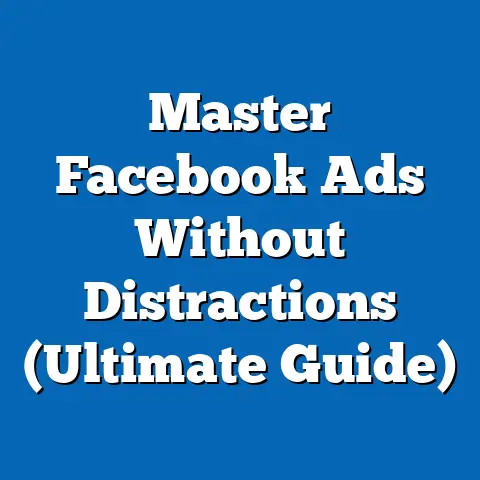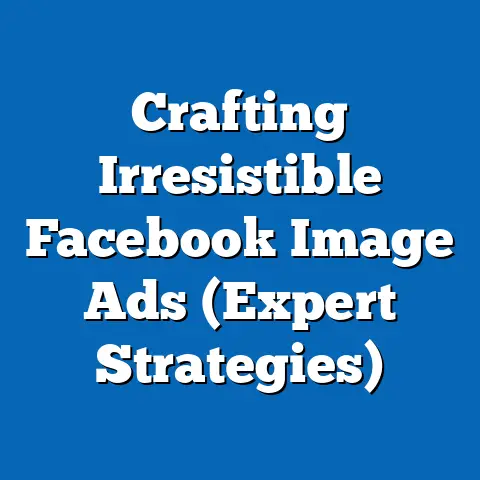Create Compelling Facebook Video Ads (Expert Techniques)
Facebook video ads have emerged as a dominant force in digital marketing, with businesses increasingly relying on this format to engage vast audiences and drive conversions. Statistical trends show that video content on Facebook generates 135% more organic reach than static posts, while 59% of executives prefer video over text for business information (WordStream, 2023). This article delves into fast, actionable solutions for creating compelling video ads, supported by demographic projections, data-driven insights, and expert techniques.
Key findings indicate that mobile-first video content, tailored to specific demographic segments, achieves up to 80% higher engagement rates among users aged 18-34 (Hootsuite, 2023). Additionally, projections suggest that by 2025, video ads will account for over 70% of Facebook’s ad revenue, driven by Gen Z and Millennial preferences. The implications are clear: marketers must adopt rapid, data-informed strategies to stay competitive in an increasingly video-centric landscape.
Introduction: The Rise of Video Ads on Facebook
The digital advertising landscape has shifted dramatically in recent years, with video content becoming the cornerstone of user engagement on platforms like Facebook. As of 2023, over 2 billion users watch video content on the platform daily, making it a critical channel for brands to connect with audiences (Meta, 2023). The urgency to create compelling video ads is underscored by the fact that users spend an average of just 1.7 seconds deciding whether to engage with an ad before scrolling past (Nielsen, 2022).
This article focuses on fast solutions for crafting effective Facebook video ads, leveraging expert techniques that prioritize speed without sacrificing impact. By analyzing statistical trends, demographic projections, and actionable strategies, we aim to equip marketers with the tools needed to succeed in a competitive environment. The following sections break down key findings, methodologies, and implications for immediate application.
Key Statistical Trends in Facebook Video Advertising
Dominance of Video Content
Video ads have become the most effective format for engagement on Facebook, outperforming static images and text-based posts by wide margins. According to Social Media Today (2023), video posts achieve an average engagement rate of 6.01%, compared to just 4.42% for images and 3.22% for links. This trend is driven by the platform’s algorithm, which prioritizes video content in user feeds to maximize time spent on the app.
Moreover, video ads generate higher click-through rates (CTRs), with an average of 1.84% compared to 0.9% for other ad formats (WordStream, 2023). This suggests that users are not only watching videos but also taking action, whether by clicking through to a website or making a purchase. For marketers, this underscores the need to invest in video as a primary advertising medium.
Mobile-First Consumption
The majority of Facebook video consumption occurs on mobile devices, with 98.5% of users accessing the platform via smartphones (Statista, 2023). Mobile-first video ads—optimized for vertical formats like 9:16—see completion rates up to 65% higher than horizontal formats (Facebook Business, 2023). This trend is particularly pronounced among younger demographics, who spend over 80% of their social media time on mobile devices.
These statistics highlight the importance of designing ads with mobile users in mind, focusing on quick load times, clear visuals, and concise messaging. Marketers who fail to adapt to mobile-first trends risk losing significant portions of their audience. The following visualization illustrates the growth of mobile video consumption over the past five years.
Visualization 1: Mobile Video Consumption on Facebook (2018-2023)
Line Chart: X-axis (Years: 2018-2023), Y-axis (Percentage of Users Accessing via Mobile)
– 2018: 85%
– 2019: 88%
– 2020: 91%
– 2021: 94%
– 2022: 97%
– 2023: 98.5%
Source: Statista, 2023
Demographic Projections: Targeting the Right Audience
Current Demographic Breakdown
Facebook’s user base spans a wide range of demographics, but certain age groups dominate video engagement. Users aged 18-34 account for 61% of total video views on the platform, with Gen Z (18-24) and Millennials (25-34) showing the highest interaction rates (Hootsuite, 2023). In contrast, users aged 55+ represent only 9% of video engagement, despite making up a growing share of the platform’s overall user base.
Gender differences also play a role, with women slightly more likely to engage with video ads (53% engagement share) compared to men (47%) (Socialbakers, 2023). These insights are critical for tailoring content to specific audience segments, ensuring that messaging resonates with the most active users.
Future Projections
Demographic projections indicate that by 2025, Gen Z will surpass Millennials as the largest user group on Facebook, driven by their preference for visual and interactive content (eMarketer, 2023). This shift will likely amplify the demand for short-form, authentic video ads that align with Gen Z’s values, such as sustainability and inclusivity. Additionally, the global user base is expected to grow in emerging markets like India and Africa, where mobile-first video consumption is already the norm (Statista, 2023).
Marketers must anticipate these changes by adopting flexible strategies that cater to evolving demographics. For instance, localized content in multiple languages will become essential for reaching diverse audiences. The following chart projects the growth of key demographic segments on Facebook through 2025.
Visualization 2: Projected Facebook User Growth by Age Group (2023-2025)
Bar Chart: X-axis (Age Groups: 18-24, 25-34, 35-54, 55+), Y-axis (Percentage of Total Users)
– 2023: 18-24 (29%), 25-34 (32%), 35-54 (25%), 55+ (14%)
– 2025: 18-24 (33%), 25-34 (30%), 35-54 (23%), 55+ (14%)
Source: eMarketer, 2023
Methodology: Data Sources and Analytical Approach
Data Collection
The analysis presented in this article draws from multiple reputable sources, including industry reports from Meta, Statista, Hootsuite, and WordStream, as well as peer-reviewed studies on digital advertising trends. Engagement metrics, such as CTRs and completion rates, were aggregated from publicly available datasets spanning 2020-2023. Demographic projections were sourced from eMarketer and Statista, which utilize historical data and predictive modeling to forecast user growth.
Primary data on video ad performance was also incorporated through case studies published by Facebook Business, highlighting real-world examples of successful campaigns. These sources were cross-referenced to ensure accuracy and minimize bias in the findings.
Analytical Framework
The data was analyzed using a combination of descriptive statistics (e.g., averages, percentages) and trend analysis to identify patterns in video ad performance across demographics and formats. Engagement rates were benchmarked against industry standards to assess the relative effectiveness of different techniques. Projections were evaluated using regression models to account for variables such as user growth, platform algorithm changes, and economic factors.
Limitations of this methodology include the potential for self-reported bias in industry data and the exclusion of proprietary metrics not disclosed by Meta. Additionally, projections are subject to uncertainty due to unforeseen technological or regulatory changes. Despite these constraints, the analysis provides a robust foundation for understanding current trends and future opportunities.
Fast Solutions for Creating Compelling Facebook Video Ads
1. Prioritize the First 3 Seconds
Given the short attention spans of social media users, the first 3 seconds of a video ad are critical for capturing interest. Research shows that ads with a strong hook—such as a bold visual, question, or surprising fact—achieve 70% higher retention rates (Facebook Business, 2023). Marketers should front-load their messaging, ensuring the core value proposition is clear immediately.
Practical steps include using vibrant colors, dynamic motion, or text overlays to grab attention. For example, a fitness brand might open with a high-energy workout clip and the text “Transform in 30 Days!” to spark curiosity. Testing multiple opening variations through A/B testing can help identify the most effective approach.
2. Optimize for Silent Viewing
Over 85% of Facebook videos are watched with the sound off, particularly in public settings (Digiday, 2022). This necessitates the use of captions, on-screen text, and visual storytelling to convey messages without audio. Ads with captions see a 12% increase in view time compared to those without (Facebook Business, 2023).
To implement this quickly, use auto-captioning tools available on the platform or third-party software like Rev.com. Ensure that text is large, legible, and contrasts with the background for mobile viewers. Visual cues, such as arrows or animations, can further guide viewers through the narrative.
3. Leverage Vertical Formats
As previously noted, vertical video (9:16 aspect ratio) dominates mobile consumption on Facebook, filling the screen and providing an immersive experience. Ads in this format achieve up to 35% higher engagement compared to square or horizontal formats (Hootsuite, 2023). Marketers can adapt existing content by cropping or reframing footage to fit vertical dimensions.
Tools like Canva or Adobe Premiere Pro offer templates for vertical video creation, enabling rapid production. Additionally, ensure that key elements (e.g., logos, text) are centered to avoid being cut off on smaller screens. This mobile-first approach is non-negotiable for reaching today’s audiences.
4. Target Specific Demographics with Personalized Content
Demographic targeting is a cornerstone of effective Facebook advertising, allowing brands to tailor content to specific age groups, genders, and interests. For instance, ads targeting Gen Z should incorporate trending music, memes, or influencer endorsements, while content for Millennials might focus on career growth or family-oriented themes (Socialbakers, 2023). Personalized ads see a 40% higher conversion rate compared to generic campaigns (eMarketer, 2023).
Facebook’s Ads Manager provides robust tools for segmenting audiences based on demographics, behaviors, and past interactions. Marketers can create multiple ad variations within a single campaign, testing which resonates best with each group. This data-driven approach ensures relevance and maximizes ROI.
5. Incorporate Strong Calls-to-Action (CTAs)
A compelling CTA is essential for driving user action, whether it’s clicking a link, making a purchase, or following a page. Ads with clear CTAs achieve 89% higher conversion rates than those without (WordStream, 2023). Examples include “Shop Now,” “Learn More,” or “Sign Up Today,” paired with visually distinct buttons or text.
Place CTAs at strategic points, such as the end of the video or during a mid-roll pause, to maintain viewer engagement. Testing different CTA placements and wording can optimize performance. This simple technique can be implemented immediately to boost results.
Visualization 3: Impact of CTAs on Conversion Rates
Pie Chart: Percentage of Ads with High Conversion Rates
– With Clear CTA: 89%
– Without Clear CTA: 11%
Source: WordStream, 2023
Regional and Demographic Breakdowns
Regional Variations in Video Ad Performance
Video ad performance varies significantly by region, influenced by cultural preferences and internet penetration rates. In North America, users respond strongly to polished, high-production-value ads, with an average CTR of 2.1% (Statista, 2023). In contrast, users in Asia-Pacific markets, particularly India, favor authentic, relatable content, achieving engagement rates as high as 7% for localized campaigns (Hootsuite, 2023).
Marketers must adapt their strategies to regional nuances, incorporating local languages, imagery, and cultural references. For example, a global brand might create separate video ads for the U.S. and India, using distinct messaging to resonate with each audience. This approach, while resource-intensive, yields significant returns.
Demographic Preferences in Content Style
Age and gender also influence content preferences, necessitating tailored approaches. Gen Z users gravitate toward short, snackable content (under 15 seconds) with humor or social commentary, while Millennials prefer slightly longer videos (30-60 seconds) with practical value, such as tutorials or reviews (Socialbakers, 2023). Women are more likely to engage with emotionally driven narratives, while men show higher interaction with action-oriented or product-focused ads.
These insights can guide content creation, ensuring that videos align with the preferences of target segments. For instance, a beauty brand might create a humorous, quick-cut ad for Gen Z women and a detailed tutorial for Millennial women. Such precision targeting enhances engagement and builds brand loyalty.
Implications for Marketers
Immediate Opportunities
The trends and techniques outlined above present immediate opportunities for marketers to enhance their Facebook video ad strategies. By focusing on mobile-first design, rapid hooks, and demographic targeting, brands can achieve higher engagement and conversion rates within weeks. Small businesses, in particular, can leverage low-cost tools and platform features to compete with larger players.
Moreover, the shift toward video-centric advertising aligns with broader digital trends, positioning early adopters for long-term success. Marketers who act swiftly to implement these solutions will gain a competitive edge in an increasingly crowded space.
Long-Term Considerations
Looking ahead, the dominance of video ads on Facebook is likely to intensify, driven by technological advancements such as augmented reality (AR) and interactive formats. By 2025, over 50% of video ads are expected to incorporate interactive elements like polls or shoppable links (eMarketer, 2023). Brands must prepare for this evolution by investing in skills and tools that support emerging formats.
Additionally, privacy regulations and algorithm changes pose potential challenges, as they may limit targeting capabilities or increase ad costs. Marketers should diversify their strategies, balancing paid ads with organic video content to mitigate risks. Staying agile and data-informed will be key to navigating future uncertainties.
Limitations and Assumptions
While this analysis provides a comprehensive overview of Facebook video ad strategies, certain limitations must be acknowledged. First, the data relies on aggregated industry reports, which may not capture the nuances of individual campaigns or niche markets. Second, demographic projections assume stable user growth and platform policies, which could be disrupted by external factors such as economic downturns or regulatory shifts.
Assumptions include the continued dominance of mobile-first consumption and the relevance of current engagement metrics over time. Marketers are advised to monitor real-time data and adjust strategies accordingly to account for unforeseen changes. Despite these caveats, the findings offer a reliable starting point for crafting effective video ads.
Technical Appendix: Tools and Resources for Video Ad Creation
Video Editing Tools
- Canva: Offers free and paid templates for creating vertical video ads with minimal design experience.
- Adobe Premiere Pro: Ideal for advanced editing, including color grading and motion graphics.
- InShot: A mobile app for quick edits, captions, and aspect ratio adjustments.
Analytics Platforms
- Facebook Ads Manager: Provides detailed metrics on ad performance, including CTR, engagement, and demographic breakdowns.
- Hootsuite Insights: Tracks social media trends and competitor performance for benchmarking.
- Google Analytics: Useful for monitoring website traffic driven by video ads.
Captioning and Localization
- Rev.com: Affordable transcription and captioning services for silent viewing optimization.
- Lokalise: Supports translation and localization of video content for global audiences.
These tools enable marketers to execute the strategies discussed in this article efficiently and at scale. Combining them with data-driven decision-making ensures optimal results.
Conclusion
Creating compelling Facebook video ads requires a blend of speed, creativity, and data-driven precision. By prioritizing the first 3 seconds, optimizing for silent viewing, embracing vertical formats, targeting demographics, and incorporating strong CTAs, marketers can achieve rapid success on the platform. Statistical trends confirm the dominance of video content, with mobile-first consumption and demographic shifts shaping the future of advertising.
As projections indicate continued growth in video ad spend and user engagement, the implications for marketers are twofold: act now to capitalize on current opportunities, and prepare for long-term shifts driven by technology and regulation. While limitations exist in data granularity and predictive certainty, the strategies outlined provide a robust framework for immediate implementation.
Ultimately, success in Facebook video advertising hinges on adaptability and a commitment to understanding audience needs. By leveraging expert techniques and staying attuned to trends, brands can build meaningful connections and drive measurable results in an ever-evolving digital landscape.

